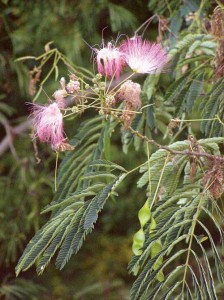My favorite tree has to go

Fern-like leaves, frilly flowers and twisted bean pods characterize invasive mimosa. Photo by Ken Moore.
By Ken Moore
Last week, several Citizen readers said to me, “Ken, you should write about exotic invasives!†My response: “Well, I do occasionally write about them, but I try to focus more on the beauty of our native flora.†How appropriate then that this past week’s Citizen carried a front-page article titled, “Carrboro updates its invasive plants list.â€
At the top of Carrboro’s new Do Not Plant list are two trees featured in the July 12, 2007 Flora. Some of you may remember them.
I spent childhood days playing under a neighbor’s giant mimosa tree with fragrant silky flowers in summer and twisted bean pods in the fall. The mimosa, also called silktree, Albizia julibrissin, remains for me one of the most exotically beautiful of all trees. And exotic it is, having been introduced from Asia in the mid-1700s, though it’s now at home throughout North Carolina and the entire Southeast. I’m still trying to get rid of one I set in my yard two decades ago. The staff of the N. C. Botanical Garden has had success eradicating a formerly persistent population along the Coker Pinetum on Manning Drive.
Magnificent specimens of mimosa thrive throughout Carrboro and Chapel Hill. Though you are most likely not going to cut down a specimen, you do need to be aware that those bean pods can spread far beyond your yard. We should be concerned about the big specimen below the Morgan Creek bridge on Smith Level Road. The creek provides seed dispersal for future trees all the way down to Jordan Lake and beyond. Those magnificent specimens in the vicinity of the Courtyard on West Franklin Street pose a similar threat. Those seeds reach Jordan Lake via storm drains into that same Morgan Creek.
Another vigorous exotic, expressing itself now along field and woodland edges, as well as on paved urban sites, is Tree of Heaven, Ailanthus altissima. It was introduced in the late 1700s from Europe, to where it had earlier been imported from China for potential silkworm production. The intended silkworm industry failed in Europe and America, but that tree has succeeded all too well, now displacing native trees and shrubs. You can’t miss it along woodland edges of the Calvander approach to Carrboro and along the bypass between Jones Ferry and Smith Level roads.
You can easily spot single specimens or thickets of upright stems with compound leaves of 10 to 40 leaflets. Vigorous clusters of yellow-green winged fruit on the female trees maturing to a striking rusty red and brown in the late summer are eye catching.
Both of these trees, among others, are on Carrboro’s newly adopted list, which is “Rank 1-Severe Threat†of the North Carolina Native Plant Society Invasive Exotic Species List. You are encouraged to visit ncwildflower.org/invasives/list.htm for other categories of invasive plants.
I will most likely continue this topic next week.
In the meantime, I’ll continue my own battle with my formerly favorite mimosa and will never allow Tree of Heaven a foothold on my property. The nature of our roadsides and forests is in our hands. You will have to decide how responsible you are going to be.


Trackbacks and Pingbacks
Comments are closed.